In the studio
The Beatles started recording ‘Hey Jude’ on 29 July 1968. That first session was more of a rehearsal than a proper session: The Beatles knew it would be their next single, and dedicated the time to perfecting the arrangement.
Paul McCartney sang and played piano, John Lennon was on acoustic guitar, George Harrison played electric guitar, and Ringo Starr was on drums. They recorded six takes, only three of which were complete, and each notably shorter than the final version.
The first take was released in 2018 on the super deluxe 50th anniversary reissue of the White Album. Take two had been issued in 1996 on Anthology 3.
On ‘Hey Jude’, when we first sat down and I sang ‘Hey Jude…’, George went ‘nanu nanu’ on his guitar. I continued, ‘Don’t make it bad…’ and he replied ‘nanu nanu’. He was answering every line – and I said, ‘Whoa! Wait a minute, now. I don’t think we want that. Maybe you’d come in with answering lines later. For now I think I should start it simply first.’ He was going, ‘Oh yeah, OK, fine, fine.’ But it was getting a bit like that. He wasn’t into what I was saying…I did want to insist that there shouldn’t be an answering guitar phrase in ‘Hey Jude’ – and that was important to me – but of course if you tell a guitarist that, and he’s not as keen on the idea as you are, it looks as if you’re knocking him out of the picture. I think George felt that: it was like, ‘Since when are you going to tell me what to play? I’m in The Beatles too.’ So I can see his point of view.
Anthology
The next evening The Beatles continued working on the track, recording takes 7-23. George Harrison played guitar on some early takes, but spent much of the session in the studio control room. The recording was filmed for a documentary by the National Music Council of Great Britain, who captured the group playing and chatting for a short colour film called Music!.
At the end of the session George Martin made a rough mix of the song, in order to score it for the orchestra which was booked for 1 August.
‘Hey Jude’ has become a classic. It felt good recording it. We put it down a couple of times – trying to get it right – and, like everything else, it just clicked. That’s how it should be.
Anthology
On 31 July 1968 The Beatles decamped to Trident, an independent studio on London’s Wardour Street which had eight-track recording facilities. They began re-recording ‘Hey Jude’, laying down four takes of the song’s rhythm track.
There is an amusing story about recording it. We were at Trident Studios in Soho, and Ringo walked out to go to the toilet and I hadn’t noticed. The toilet was only a few yards from his drum booth, but he’d gone past my back and I still thought he was in his drum booth. I started what was the actual take, and ‘Hey Jude’ goes on for hours before the drums come in and while I was doing it I suddenly felt Ringo tiptoeing past my back rather quickly, trying to get to his drums. And just as he got to his drums, boom boom boom, his timing was absolutely impeccable. So I think when those things happen, you have a little laugh and a light bulb goes off in your head and you think, This is the take! And you put a little more into it. You think, oh, f**k! This has got to be the take, what just happened was so magic! So we did that and we made a pretty good record.
Many Years From Now, Barry Miles
The song was completed the next day. McCartney added his bass and lead vocals, and the other Beatles contributed backing vocals. The 36-strong orchestra then added backing for the lengthy four-chord coda. The classical musicians were also offered a double fee for clapping and singing along to the ‘nah nah nah’ chant.
Most of the musicians were happy to oblige, especially as it meant a doubled fee, but there was one dissenter who reportedly walked out, saying “I’m not going to clap my hands and sing Paul McCartney’s bloody song!”
Mark Lewisohn
‘Hey Jude’ contains an unedited expletive, which is often played by radio stations to this day. In the final verse, John Lennon sang “Let her into” instead of “Let her under your skin”. His cry of “Oh!”, followed by “F*****g hell”, remains in the final mix.
I was told about it at the time but could never hear it. But once I had it pointed out I can’t miss it now. I have a sneaking suspicion they knew all along, as it was a track that should have been pulled out in the mix. I would imagine it was one of those things that happened – it was a mistake, they listened to it and thought, ‘doesn’t matter, it’s fine’.
The Complete Beatles Recording Sessions, Mark Lewisohn


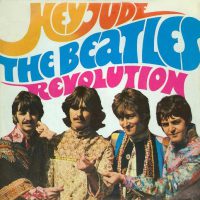
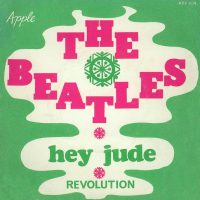
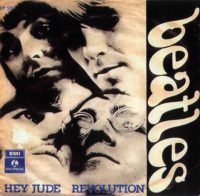
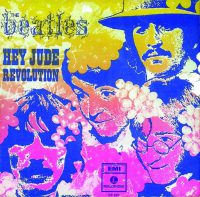
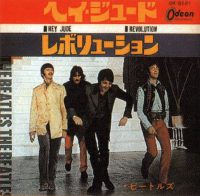
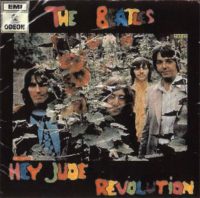
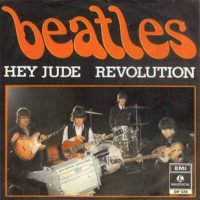


If you listen on YouTube to the ‘Love’ version of HJ, you can hear a different, more lively version of the bass part during the Na-na-na’s. It sounds like the Fender VI bass, so I’m guessing this is an alternate track, with George taking some liberties. listen starting at 3:00 on the video
Actually, Paul was the only bassist at the recording session and I have seen a photograph taken of him at Trident Studios with his left-handed Fender Jazz Bass, so it was most likely the first time he used it on a recording, not his Rickenbacker or Hofner basses.
George only played the Fender 6-string bass on the David Frost Show performance and it was partially mimed with live vocals, due to a Musicians’ Union ban on lip-synching.
It’s always interesting to read through the comments on personal interpretations of these songs. I am guilty of doing it myself. And, of course, the Beatles themselves have been known to revise and invent things over time. For this one, I could never reconcile the last 3 verses with the first one, which is obviously about Julian. That is, until I heard a little snippet about the song from Paul on the Beatles channel. He talked about how John felt the later verses were about him and Yoko. In actuality, according to Paul, they were about Paul and Linda, with Paul trying to convince himself that it was ok to get serious with her (e.g., “Don’t be afraid, you were made to go out and get her”). It actually makes more sense this way.
Paul did try and dodge the meanings of some of his more personal songs. I don’t believe Paul saying it was about Linda one bit. I think it’s just convenient for him for how people want to interpret it. No doubt it was inspired by Julian but the lyrics are more about self-reproach. Firstly, it was written just after Jane Asher left him. And, like Paul said, written on the journey to see Julian where Cynthia said Paul was heartbroken over Jane and had admitted it was all his fault. A little too coincidental? This was corroborated by others around this time and later by Elvis Costello when he worked with Paul on Flowers in the Dirt (several songs on that album were about unrequited love). There was nothing to stop Paul reaching out to Linda during this time. Instead he made a big effort to win Jane back and had affairs with Francie Schwartz and Maggie McGivern before settling with Linda months later. Either it’s Paul’s pride or ego or he’s trying to protect the image of his marriage, especially after the Heather Mills debacle. A bit of both probably.
.
Kalle,
Paul McCartney first met Linda at the Bag O’ Nail on May 15, 1967. Where he stood up and block Linda way from leaving. Paul asking Linda if she would like to go with him and his group of friends to another bar. And Paul would have said in an interview later on that he knew Linda was Woman! And Linda has a daughter Heather which Paul loves kids. So, Paul stays in touch with Linda.
Paul goes up to see Cynthia and Julian sometime in May of 1968, when John was divorcing Cynthia. And Paul decides to write a Song for Julian called “Hey Jude”.
On July 20, 1968 Jane Asher calls it quits with Paul on Simon Dee’s BBC Television Show. And I know Paul and Jane have been having troubles for years. With Songs like “We Can Work It Out” Released December 3, 1965 and “For No One” Released August 5, 1966 – “A Love that should have lasted years” – The Songs working title was “Why Did It Die?”, Paul said he have a fight with Jane while they on vacation together in the Swiss Alps. Paul knew that things were not going well for them in May of 1968 when he had gone and saw Cynthia and Julian. Paul, Knowing that Jane was finish with him when she caught him in bed with Francie Schwartz (allegedly) during the “White Album”, sometime in June- July of 1968.
When Paul was writing “Hey Jude” he was course thinking about Julian but Paul was thinking about himself, too.
“Hey Jude” – Released on August 26, 1968 (USA) and August 30, 1968 (UK).
“Hey Jude”
“Hey Jude, Don’t make bad
Take a sad song and make it better
Remember to let her into your heart
Then you can start to make it better
Hey Jude, don’t be afraid
You were made to go out and get her
The minute you let her under your skin
Then you begin to make things better”
These two verses could be a message to himself – Saying it is over between Jane and himself {Paul} (Sad Song). And by letting Linda in, you {Paul} could start to make things better. But, first you {Paul} have to go out and get her {Linda}.
He does! And Paul & Linda daughter Mary McCartney was born a year later on August 28, 1969.
I, believe that Paul has Linda on his mind when writing “Hey Jude”.
I would to add to the comment I just made about “Hey Jude” on February 2, 2023 – When
John Lennon and Paul McCartney went to the USA to promote “Apple” on May 11, 1968, Paul saw Linda Eastman. So, I believe Paul McCartney when he said that “Hey Jude” was about him getting the confidence to go out and get Linda.
Hello all, I’m from Melbourne Australia. I remember Hey Jude on the radio, and every Sunday night a local radio station would play its top ten or twenty and every week for ages Hey Jude/Revolution was number one. I always enjoyed listening to it. My question is was Hey Jude/Revolution released as a double A side here in Australia. I read once on the Beatles Bible site that Revolution was the B side, but I was always under the impression it was a double A release . Maybe the radio station released its own list but I was always under the impression it was double A. Anyone can enlighten me?
Stephen Holland, “Hey Jude” was recorded on July 31, 1968, and August 1, 1968. “Hey Jude” was released on the A side on August 26, 1968. And on the B SIDE (Not A DOUBLE A) was Revolution.
When I was a kid, I wondered if the nah nah nah hey Jude part of the song was influenced by the song Nah Nah Hey Hey Kiss Him Goodbye by a group called Steam. I see now that the latter wasn’t released until later in 1969. So it must have been the other way around. Imagine that…a 1960’s song influenced by the Beatles! Go figure…
Saw the boys do both “Hey Jude” and “Revolution” on the Smothers Brothers TV show. At the time, I thought it was live, didn’t realize it was taped beforehand.
Phillip, Paul often talks about people and writes songs about the past or near past in the present tense. It’s unusual and he does this with John Lennon as well. He’s never said Hey Jude was about Linda in the past, not in 1970 or 1980 or when she died in 1998. Or in Many Years From Now. Why not though? And why recently? There was nothing to stop him attributing it to Linda at any time if that was the case. He knows that line you quoted can be interpreted about any woman. He continued his loveless affair with Francie Schwartz for a short time while still trying to win Jane back before taking Maggie McGivern on holiday for two weeks in September. Wasn’t Linda and her child supposed to be ready and waiting for him? Why didn’t he ‘go out and get her’? Yes, he did – eventually, that is. Hey Jude wasn’t written with Linda in mind and because of their seemingly happy marriage it’s all to easy to attribute an interpretation retrospectively. As Paul does. To be honest, I don’t think Paul ever lacked the confidence to find himself a partner, and if he was that enamoured with Linda when he met her at the Bag of Nails he would have called off his relationship with Jane there and then, but obviously not. It wasn’t just Cynthia who said Paul was heartbroken over Jane, it was also Alistair Taylor and several others. But the most illogical thing of all is if Paul didn’t write Hey Jude about himself because of Jane, then why write the song in the first place? The problem with Paul being evasive about Hey Jude and other personal songs is that it could lead to doubts over what he says about the songs he wrote with John Lennon. However, I’d like to think Paul probably has his reasons for keeping some deeply-held personal feelings to himself.
.
After reading comments about the lyrics involving Jane Asher I can see how they can be interpreted that way. Maybe it was originally titled Hey Jane? I can also see them being about John so maybe it was called Hey John? Or maybe even Hey Paul? But I never read them being about Julian. Lyrically that just never made sense to me.
In the live version, McCartney sings some lyrics from, “The Weight”, by The Band, which was just released only months earlier.
just noticed that “It’s Now Or Never” has the same chords as Hey Jude. You can sing it well over it, only the 5th bar differs by major/minor. Was it John’s irony to play that song briefly?